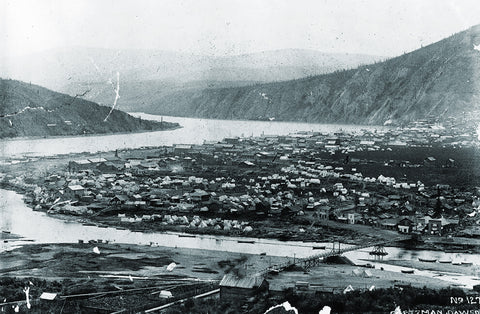
The Rise and Fall of the Boomtown Dawson City
The site of present-day Dawson City, Canada, was for centuries a summer fishing camp of the Hän-speaking First Nations people known as the Tr’ondëk Hwëch’in. Their camp, Tr’ochëk, sat at the confluence of the Yukon and Klondike Rivers in what today is Yukon territory. Then, in 1896 prospectors discovered gold near Tr’ochëk.
New York–born prospector and entrepreneur Joseph Ladue promptly staked claim to 160-plus acres at the mouth of the Klondike and then waited for the gold- hungry stampeders to arrive. He didn’t have to wait long, for by that winter some 500 people lived in what Ladue named Dawson City after Canadian geologist George Mercer Dawson. By 1898 the population exceeded 15,000.
The birth of a new city practically overnight naturally spawned infrastructure problems. But the lack of running water, sewerage, electricity, or paved streets paled in comparison to more pressing crises in winter. When the rivers froze in the winter of 1897–98, trapping some 5,000 people in Dawson City, food and adequate shelter were scarce. Many prospectors squatted in tents or shantylike wood cabins. Fire and floods posed an ever-present threat, while malaria, typhoid, and scurvy plagued the nascent town. Food and supplies were literally worth their weight in gold, as prospectors had to choose between their newfound wealth and survival.
As often happens during a gold rush, the vast majority of hopefuls found nothing, while early birds and savvy businessmen became wildly wealthy. Contrary to what happened during the lawless California Gold Rush, Canada strictly regulated mining licenses and claims, requiring significant buy-in. Permafrost in the icy north made traditional mining difficult most of the year, but those who stuck with it returned to Dawson City with plenty of gold, and a thriving economy emerged. Lean-tos and tents gradually gave way to wood- frame homes and businesses on proper streets.
By 1902 Dawson had incorporated as a city and been chosen the territorial capital. But it had also lost most of its population, dropping below 5,000 residents, as gold had been discovered farther west in Nome.
As miners left Dawson City, First Nations people began returning to their ancestral stamping grounds. Today the last fluent speaker of the Hän language, 95-year-old Percy Henry, calls Dawson City home.
historynet magazines
Our 9 best-selling history titles feature in-depth storytelling and iconic imagery to engage and inform on the people, the wars, and the events that shaped America and the world.
